Overview
- Brief Narrative
- Colorful apron returned to 20-year-old Kato Ritter by her Catholic neighbors, the Oppel family, in Vilmany, Hungary, in July 1945. Kato’s family gave the apron to the Oppels to safeguard prior to their deportation during World War II (1939-1945). Kato's initials were originally monogrammed between the red triangles. The Oppels removed the monogram from this, and other items, because they did not want to appear to have aided Jews if their home were raided. Kato wove the linen for the apron from flax plants grown on her family’s farm, and embroidered it in 1939. The family made their own noodles and, when doing so, always wore long aprons that covered them from their waist to their ankles. Nazi-controlled Germany occupied Hungary in March 1944, and one week later, 19-year-old Kato, her parents, David and Gizella, and her 17-year-old sister, Julianna, were deported from Vilmany to the Jewish ghetto in Košice, Czechoslovakia (now Košice, Slovakia). From there, they were transported to Auschwitz-Birkenau killing center, where everyone except Kato was gassed upon arrival. Kato was selected for forced labor, and sent to Peterswaldau concentration camp. The camp was liberated by the Soviet Army on May 8, 1945. That summer, Kato returned to Vilmany.
- Date
-
creation:
1939
recovered: 1945 July
- Geography
-
creation:
Vilmany (Hungary)
recovery: Vilmany (Hungary)
- Credit Line
- United States Holocaust Memorial Museum Collection, Gift of Katie and George Frankfurter
- Contributor
-
Subject:
Katie Frankfurter
Artist: Katie Frankfurter
Subject: George Frankfurter
- Biography
-
Kato Ritter (later Katie, Ida Katie Frankfurter) was born on August 26, 1925, in Vilmany, Hungary, to David and Gizella Weissburg Ritter. David was born in 1898 in Novajidrany, Hungary, to Matlyas and Kati Ritter. Gizella was born in 1900 in Olaszliszka, Hungary, to Zigmund and Pearl Klein Weissburg. Kato had one brother, Matlyas, and two sisters, Lillian and Julianna, born in 1927. Matlyas and Lillian both died at a young age. David was injured during his military service in the Hungarian Army in World War I (1914-1918.) He was a farmer, and also owned several general goods, butcher, and grocery stores in Vilmany and nearby villages. Gizella assisted in managing the stores. The family occasionally had servants and distant relatives living in the household. Kato’s maternal and paternal grandparents were observant Jews, but Kato’s family was not religious, although they did observe the high holidays. The family spoke Hungarian at home, but both parents spoke German and her father also spoke Yiddish. When Kato was six, her mother taught her embroidery. Kato attended middle school, and later attended a gymnasium in Budapest, Hungary, where she lived with a maternal aunt and uncle, the Sekes. In 1938, the German-allied Hungarian government began enacting anti-Jewish legislation, and Kato’s family was required to pay rent for their farm land to the state. In 1941 or 1942, she returned to Vilmany because her parents wanted the family together.
On March 19, 1944, German forces occupied Hungary. Shortly after, Hungarian soldiers went to each Jewish home in the village and made a list of inhabitants. A week later, Kato, her parents, her sister, and the 50 other Jewish residents of the village were gathered in the Catholic school. They were allowed to bring as many belongings as they could carry; Kato brought some food and a set of clothing. Kato was friends with a Catholic neighbor, Klara Oppel, and her family had agreed to safeguard some clothing and linens for the Ritters. Most of their money and valuables were confiscated by Hungarian soldiers. They were sent from the school to Kosice, Czechoslovakia, where they lived for a brief period in the home of a Jewish woman. Kato’s family and all the other Jews in Kosice soon were forced to move into a ghetto located in a brick factory near the town.
About two weeks later, Kato, her parents, her sister, an aunt, and a young cousin were deported from the ghetto to Auschwitz-Birkenau killing center. Her parents, her sister, her aunt, and her cousin were sent immediately to the gas chamber. SS guards selected Kato for forced labor. She was taken to a separate area where she was ordered to undress and her hair was cut short; she was allowed to keep only her shoes. She was given a prisoner’s uniform with the number, 36691. Kato was forced to write a letter to her maternal aunt and uncle in Budapest ensuring them that she was alive and well. She was placed in the same barrack as her former classmate, Manda Vermos. They slept with over 10 women to a bunk; their only food some bread and mush. During the morning roll call, the female inmates decided to put Kato in the front row because she was blonde, blue-eyed, and healthy looking. Shortly after, Kato was transferred with about 270 other women, including Manda, to Peterswaldau slave labor camp. The inmates were Polish, Czech, and Hungarian Jewish women. Kato was forced to work in a munitions factory on timing devices. She slept on a straw bed and food was scarce and she received a piece of black bread to last for five days. She once was beaten by a female SS guard after other inmates suggested that Kato looked like her. The camp was liberated by the Soviet Army on May 8, 1945.
Kato spent several weeks traveling to Budapest to reach her maternal aunt, Anna Seke, and her cousin, Viola. They had been sent to the Budapest ghetto, but returned to their home in Budapest after the war. Her maternal uncle presumably perished. In summer 1945, Kato returned to her home in Vilmany, and retrieved some of the items her family had left with the Oppel family. She met Gyorgy Frankfurter, who had survived multiple forced labor battalions, in Vilmany in 1945 and they married in August 1947 in Miskolc, Hungary. The couple illegally crossed the Austria-Hungary border to Vienna because they were unable to receive passports from the Hungarian government. They then went to Feldafing displaced persons camp near Munich, Germany. With assistance from the Hebrew Immigrant Aid Society, they emigrated to the United States in March 1951 on the USNS General Muir. Kato and Gyorgy Americanized their names to Ida Katie and George. They settled in West Hartford, Connecticut, and adopted two children. George died, age 93, on October 20, 2012.
Gyorgy Frankfurter (later George, 1919-2012) was born on October 15, 1919, in Fony, Hungary, to Miksa and Rosa Weiss Frankfurter. Miksa was born in 1892 to Abraham and Hana Frankfurter. Rosa was born in 1901 in Fony to Samuel and Fanny(?) Weiss. Gyorgy had two brothers, Ference and Imre, and one sister, Ilona. Miksa was a sergeant in the Hungarian Army during World War I. When Gyorgy was two, Miksa decided to move his family from Fony to Gonc, Hungary. He was a merchant, and also managed an inn and a textile business. The family was poor, and Gyorgy’s paternal grandmother and a distant relative, Samuel Hertz, also lived in the household. The family regularly went to synagogue and Rosa kept a kosher home. They spoke Hungarian at home, but Gyorgy’s father also spoke Yiddish. Gyorgy went to a Catholic school for two years, but his parents wanted him to learn Hebrew and Yiddish, so they sent him to a yeshiva in Miskolc, Hungary. He completed his studies in 1938.
By 1940, the German-allied Hungarian government had forbidden Jews to serve in the armed forces and established a forced labor service for all male Jews. On October 16, 1941, Gyorgy was drafted into the labor service and sent to Kosice, Czechoslovakia, for basic training. From late 1941 to early 1942, he was placed in a labor battalion under the command of Hungarian military officers that was deployed on the construction of railways and bridges in several villages in the Transylvania region of Romania. In March 1942, he received a seven day furlough to return to Gonc because the battalion had received notice that his mother, Rosa, was ill. Gyorgy came home to find that there had been some confusion because his paternal grandmother had been the one who was ill and recently passed away. He rejoined the battalion in Hungary and worked on constructing a small airfield. The brutal Hungarian guards frequently conducted beatings and hangings of the workers.
In late 1942, Gyorgy’s battalion was sent on a seven hour train ride to Tasnad-Blaja, Romania, to cut stones to repair the roadways and later dig ditches for underground power cables. The workers wore civilian clothing. Gyorgy slept in a half-built barrack and food was scarce. He was able to write home and receive mail once per month. The kapos overseeing his company would punish workers by hanging them by their hands one to two feet off the ground. During this time, Gyorgy’s friend and fellow worker, Laszlo Grunberger, was taken to Budapest, Hungary. In 1943, Gyorgy was sent to work in Czechoslovakia, and then deployed with a new battalion to the Eastern Front in Poland. He assisted with the cavalry horses and carried ammunition to Hungarian soldiers on the front lines, and in winter, he was forced to clear snow from the roadways. The company moved from village to village as Soviet forces advanced west, and stayed in former Jewish homes.
After the German occupation of Hungary in March 1944, Gyorgy received a postcard from his father, Miska, relating that his family was being sent to the ghetto in Kosice. In summer 1944, Gyorgy was assigned to dig defensive trenches and tank traps; he witnessed many casualties of his fellow workers. In late 1944, the battalion was sent to Budapest, and interned in the ghetto. Gyorgy reconnected with his friend, Laszlo, and joined his company sending heavy machinery to Germany. In December 1944, Laszlo was shot and hanged after a bookstore explosion. After this, Gyorgy hid in the factory where he had been working until a Hungarian officer he knew from his time in Transylvania allowed him to escape. He managed to get false protective papers from the Swiss consulate, which allowed him to live in the international ghetto in Budapest. Gyorgy hid in a bunker for about two weeks until Soviet forces liberated the area on January 16, 1945. He returned to Gonc.
Gyorgy learned that his parents, Miksa and Rosa, and his younger brother, Imre, were deported from the Kosice ghetto to Auschwitz-Birkenau concentration camp where they were killed upon arrival. His sister, Ilona, was deported to Bergen-Belsen concentration camp, where she died from typhus. His brother, Ference, was selected for forced labor and presumably perished. He met Kato Ritter, a survivor from the concentration camps, in Vilmany, Hungary, in 1945; they married in August 1947 in Miskolc, Hungary. The couple illegally crossed the Austria-Hungary border to Vienna because they were unable to receive passports from the Hungarian government. They then went to Feldafing displaced persons camp near Munich, Germany. With assistance from the Hebrew Immigrant Aid Society, they emigrated to the United States in March 1951 on the USNS General Muir. Gyorgy and Kato Americanized their names to George and Ida Katie. They settled in West Hartford, Connecticut, and adopted two children. George died, age 93, on October 20, 2012.
Physical Details
- Classification
-
Dress Accessories
- Category
-
Protective wear
- Object Type
-
Aprons (lcsh)
- Genre/Form
- Needlework.
- Physical Description
- Rectangular, cream-colored linen waist apron embroidered below the center with two red triangles above a full-width garland composed of alternating bunches of green, lazy daisy and running stitched leaves and colorful, whipped wheel stitched flowers. The garland consists of four bouquets with blue, pink, red, and yellow flowers alternating with a single red flower. Each segment has a long trailing length of leaves beneath. The apron is constructed from a single, loom-width piece of cloth and has neatly hemmed top and bottom edges. There is a center dart at the waist to give slight shape to the piece. A 10-inch long, white twill tie is sewn to each upper corner. The ends of the ties are fraying and the cloth is slightly discolored overall. The cloth is scarred where embroidered initials may have been removed from between the triangles.
- Dimensions
- overall: Height: 26.875 inches (68.263 cm) | Width: 23.125 inches (58.738 cm)
- Materials
- overall : linen, string, thread
Rights & Restrictions
- Conditions on Access
- No restrictions on access
- Conditions on Use
- No restrictions on use
Keywords & Subjects
Administrative Notes
- Legal Status
- Permanent Collection
- Provenance
- The embroidered apron was donated to the United States Holocaust Memorial Museum in 2010 by George and Katie Frankfurter.
- Funding Note
- The cataloging of this artifact has been supported by a grant from the Conference on Jewish Material Claims Against Germany.
- Record last modified:
- 2023-01-30 15:06:31
- This page:
- https://collections.ushmm.org/search/catalog/irn42622
Download & Licensing
In-Person Research
- By Appointment
- Request 21 Days in Advance of Visit
- Plan a Research Visit
- Request to See This Object
Contact Us
Also in George and Katie Frankfurter collection
The collection consists of artifacts and documents relating to the experiences of Kato Ritter in Hungary and Auschwitz-Birkenau and Peterswaldau concentration camps and Gyorgy Frankfurter in Hungary and forced labor battalions before and during the Holocaust, and of Kato and Gyorgy in Feldafing displaced persons camp in Germany until their immigration to the United States in 1951.
Date: approximately 1935-approximately 1951
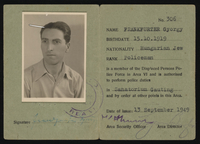
George and Katie Frankfurter papers
Document
The George and Katie Frankfurter papers include documents relating to the experiences of Kato Ritter (later Katie Frankfurter) and her husband, Gyorgy Frankfurter (later George), who both survived concentration and slave labor camps. Documents relating to Kato include a handwritten list of items requested by Kato and her family in the Budapest ghetto from an uncle in Budapest, a personal account written on scrap paper while interned in Auschwitz-Birkenau and Peterswaldau labor camp, and correspondence relating to her immigration to the United States in 1951. The collection also includes post-war identification cards including a United Nations vaccination card and a registration certificate under her Americanized name, Ida Katie. Documents relating to Gyorgy include a letter from his cousin, Sidney Wells, about life in the United States, a United Nations vaccination card, identification cards and documentation from displaced persons camps in Germany, correspondence regarding his immigration in 1951, and post-war claims documentation.
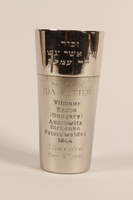
Silver-plated cup made in a slave labor camp and later engraved with Kato Ritter's name
Object
Silver-plated cup made in Peterswaldau slave labor camp where Kato (Ida) Ritter was a slave laborer from 1944-1945. She made timing devices for explosives. The timers would be placed in plastic covers attached to these decorative cups which held the explosives. People would want to pick up the cups, and removing the lid triggered an explosion. Kato was able to take one with her upon liberation. The cup was engraved in 1989 with a bible verse, her prisoner number, part of her name, place of birth, and the places and dates where she was imprisoned. Kato's husband, George, chose the Hebrew inscription, "Remember what Amalek did to you," from Deuteronomy:17, because Amalek attacked and killed the old and the weak just like the Nazis did. Nazi-controlled Germany occupied Hungary in March 1944, and one week later, 19-year-old Kato, her parents, David and Gizella, and her 17-year-old sister, Julianna, were deported from Vilmany to the Jewish ghetto in Košice, Czechoslovakia (now Košice, Slovakia). From there, they were transported to Auschwitz-Birkenau killing center, where everyone except Kato was gassed upon arrival. Kato was selected for forced labor, and sent to Peterswaldau. The camp was liberated by the Soviet Army on May 8, 1945. That summer, Kato returned to Vilmany.
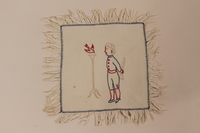
Small linen square with an embroidered boy and a bird recovered by Kato Ritter from her neighbors
Object
Small, embroidered linen square depicting a boy and a bird returned to 20-year-old Kato Ritter by her Catholic neighbors, the Oppel family, in Vilmany, Hungary, in July 1945. Kato’s family gave the linen square to the Oppels to safeguard prior to their deportation during World War II (1939-1945). It was embroidered in prewar Hungary. Nazi-controlled Germany occupied Hungary in March 1944, and one week later, 19-year-old Kato, her parents, David and Gizella, and her 17-year-old sister, Julianna, were deported from Vilmany to the Jewish ghetto in Košice, Czechoslovakia (now Košice, Slovakia). From there, they were transported to Auschwitz-Birkenau killing center, where everyone except Kato was gassed upon arrival. Kato was selected for forced labor, and sent to Peterswaldau concentration camp. The camp was liberated by the Soviet Army on May 8, 1945. That summer, Kato returned to Vilmany.
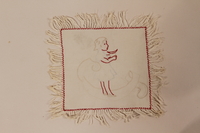
Small linen square with an embroidered girl recovered by Kato Ritter from her neighbors
Object
Small, embroidered linen square depicting a girl holding a box returned to 20-year-old Kato Ritter by her Catholic neighbors, the Oppel family, in Vilmany, Hungary, in July 1945. Kato’s family gave the linen square to the Oppels to safeguard prior to their deportation during World War II (1939-1945). It was embroidered in prewar Hungary. Nazi-controlled Germany occupied Hungary in March 1944, and one week later, 19-year-old Kato, her parents, David and Gizella, and her 17-year-old sister, Julianna, were deported from Vilmany to the Jewish ghetto in Košice, Czechoslovakia (now Košice, Slovakia). From there, they were transported to Auschwitz-Birkenau killing center, where everyone except Kato was gassed upon arrival. Kato was selected for forced labor, and sent to Peterswaldau concentration camp. The camp was liberated by the Soviet Army on May 8, 1945. That summer, Kato returned to Vilmany.
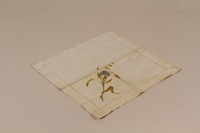
Challah cover with an embroidered blue flower recovered by Kato Ritter from her neighbors
Object
Challah cover returned to 20-year-old Kato Ritter by her Catholic neighbors, the Oppel family, in Vilmany, Hungary, in July 1945. Kato’s family gave the challah cover to the Oppels to safeguard prior to their deportation during World War II (1939-1945). It was embroidered by Kato’s mother, Gizella Weissburg Ritter, in prewar Hungary. It was used to cover the two braided bread loaves, challah, at the beginning of a Shabbat meal. Nazi-controlled Germany occupied Hungary in March 1944, and one week later, 19-year-old Kato, her parents, David and Gizella, and her 17-year-old sister, Julianna, were deported from Vilmany to the Jewish ghetto in Košice, Czechoslovakia (now Košice, Slovakia). From there, they were transported to Auschwitz-Birkenau killing center, where everyone except Kato was gassed upon arrival. Kato was selected for forced labor, and sent to Peterswaldau concentration camp. The camp was liberated by the Soviet Army on May 8, 1945. That summer, Kato returned to Vilmany.
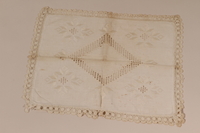
Table covering with elaborate whitework embroidery and a crocheted border recovered by Kato Ritter from her neighbors
Object
Table covering returned to 20-year-old Kato Ritter by her Catholic neighbors, the Oppel family, in Vilmany, Hungary, in July 1945. Kato’s family gave the pillow sham to the Oppels to safeguard prior to their deportation during World War II (1939-1945). It was embroidered by Kato’s mother, Gizella Weissburg Ritter, in prewar Hungary. Nazi-controlled Germany occupied Hungary in March 1944, and one week later, 19-year-old Kato, her parents, David and Gizella, and her 17-year-old sister, Julianna, were deported from Vilmany to the Jewish ghetto in Košice, Czechoslovakia (now Košice, Slovakia). From there, they were transported to Auschwitz-Birkenau killing center, where everyone except Kato was gassed upon arrival. Kato was selected for forced labor, and sent to Peterswaldau concentration camp. The camp was liberated by the Soviet Army on May 8, 1945. That summer, Kato returned to Vilmany.
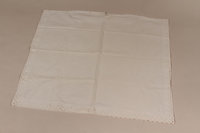
Large embroidered white pillowcase with scalloped edges recovered by Kato Ritter from her neighbors
Object
Pillowcase returned to 20-year-old Kato Ritter by her Catholic neighbors, the Oppel family, in Vilmany, Hungary, in July 1945. Kato’s family gave the pillowcase to the Oppels to safeguard prior to their deportation during World War II (1939-1945). It was embroidered by Kato’s mother, Gizella Weissburg Ritter, in prewar Hungary. Nazi-controlled Germany occupied Hungary in March 1944, and one week later, 19-year-old Kato, her parents, David and Gizella, and her 17-year-old sister, Julianna, were deported from Vilmany to the Jewish ghetto in Košice, Czechoslovakia (now Košice, Slovakia). From there, they were transported to Auschwitz-Birkenau killing center, where everyone except Kato was gassed upon arrival. Kato was selected for forced labor, and sent to Peterswaldau concentration camp. The camp was liberated by the Soviet Army on May 8, 1945. That summer, Kato returned to Vilmany.
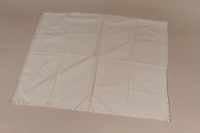
Large embroidered white pillowcase with scalloped edges recovered by Kato Ritter from her neighbors
Object
Pillowcase returned to 20-year-old Kato Ritter by her Catholic neighbors, the Oppel family, in Vilmany, Hungary, in July 1945. Kato’s family gave the pillowcase to the Oppels to safeguard prior to their deportation during World War II (1939-1945). It was embroidered by Kato’s mother, Gizella Weissburg Ritter, in prewar Hungary. Nazi-controlled Germany occupied Hungary in March 1944, and one week later, 19-year-old Kato, her parents, David and Gizella, and her 17-year-old sister, Julianna, were deported from Vilmany to the Jewish ghetto in Košice, Czechoslovakia (now Košice, Slovakia). From there, they were transported to Auschwitz-Birkenau killing center, where everyone except Kato was gassed upon arrival. Kato was selected for forced labor, and sent to Peterswaldau concentration camp. The camp was liberated by the Soviet Army on May 8, 1945. That summer, Kato returned to Vilmany.
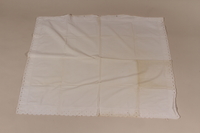
Large embroidered white pillowcase with scalloped edges recovered by Kato Ritter from her neighbors
Object
Pillowcase returned to 20-year-old Kato Ritter by her Catholic neighbors, the Oppel family, in Vilmany, Hungary, in July 1945. Kato’s family gave the pillowcase to the Oppels to safeguard prior to their deportation during World War II (1939-1945). It was embroidered by Kato’s mother, Gizella Weissburg Ritter, in prewar Hungary. Nazi-controlled Germany occupied Hungary in March 1944, and one week later, 19-year-old Kato, her parents, David and Gizella, and her 17-year-old sister, Julianna, were deported from Vilmany to the Jewish ghetto in Košice, Czechoslovakia (now Košice, Slovakia). From there, they were transported to Auschwitz-Birkenau killing center, where everyone except Kato was gassed upon arrival. Kato was selected for forced labor, and sent to Peterswaldau concentration camp. The camp was liberated by the Soviet Army on May 8, 1945. That summer, Kato returned to Vilmany.
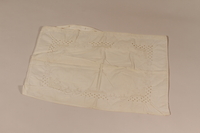
Large white pillowcase embroidered with a floral design recovered by Kato Ritter from her neighbors
Object
Pillowcase returned to 20-year-old Kato Ritter by her Catholic neighbors, the Oppel family, in Vilmany, Hungary, in July 1945. Kato’s family gave the pillowcase to the Oppels to safeguard prior to their deportation during World War II (1939-1945). It was embroidered in prewar Hungary. The Oppels removed the monogram from this, and other items, because they did not want to appear to have aided Jews if their home was raided. Nazi-controlled Germany occupied Hungary in March 1944, and one week later, 19-year-old Kato, her parents, David and Gizella, and her 17-year-old sister, Julianna, were deported from Vilmany to the Jewish ghetto in Košice, Czechoslovakia (now Košice, Slovakia). From there, they were transported to Auschwitz-Birkenau killing center, where everyone except Kato was gassed upon arrival. Kato was selected for forced labor, and sent to Peterswaldau concentration camp. The camp was liberated by the Soviet Army on May 8, 1945. That summer, Kato returned to Vilmany.
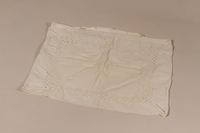
Large white pillowcase embroidered with a floral design recovered by Kato Ritter from her neighbors
Object
Pillowcase returned to 20-year-old Kato Ritter by her Catholic neighbors, the Oppel family, in Vilmany, Hungary, in July 1945. Kato’s family gave the pillowcase to the Oppels to safeguard prior to their deportation during World War II (1939-1945). It was embroidered in prewar Hungary. The Oppels removed the monogram from this, and other items, because they did not want to appear to have aided Jews if their home was raided. Nazi-controlled Germany occupied Hungary in March 1944, and one week later, 19-year-old Kato, her parents, David and Gizella, and her 17-year-old sister, Julianna, were deported from Vilmany to the Jewish ghetto in Košice, Czechoslovakia (now Košice, Slovakia). From there, they were transported to Auschwitz-Birkenau killing center, where everyone except Kato was gassed upon arrival. Kato was selected for forced labor, and sent to Peterswaldau concentration camp. The camp was liberated by the Soviet Army on May 8, 1945. That summer, Kato returned to Vilmany.
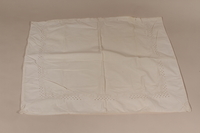
Large white pillowcase embroidered with a floral design recovered by Kato Ritter from her neighbors
Object
Pillowcase returned to 20-year-old Kato Ritter by her Catholic neighbors, the Oppel family, in Vilmany, Hungary, in July 1945. Kato’s family gave the pillowcase to the Oppels to safeguard prior to their deportation during World War II (1939-1945). It was embroidered in prewar Hungary. The Oppels removed the monogram from this, and other items, because they did not want to appear to have aided Jews if their home were raided. Nazi-controlled Germany occupied Hungary in March 1944, and one week later, 19-year-old Kato, her parents, David and Gizella, and her 17-year-old sister, Julianna, were deported from Vilmany to the Jewish ghetto in Košice, Czechoslovakia (now Košice, Slovakia). From there, they were transported to Auschwitz-Birkenau killing center, where everyone except Kato was gassed upon arrival. Kato was selected for forced labor, and sent to Peterswaldau concentration camp. The camp was liberated by the Soviet Army on May 8, 1945. That summer, Kato returned to Vilmany.
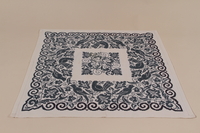
Tablecloth embroidered with a blue bird and flower design recovered by Kato Ritter from her neighbors
Object
Counted cross-stitch tablecloth returned to 20-year-old Kato Ritter by her Catholic neighbors, the Oppel family, in Vilmany, Hungary, in July 1945. Kato’s family gave the tablecloth to the Oppels to safeguard prior to their deportation during World War II (1939-1945). It was embroidered in prewar Hungary. Nazi-controlled Germany occupied Hungary in March 1944, and one week later, 19-year-old Kato, her parents, David and Gizella, and her 17-year-old sister, Julianna, were deported from Vilmany to the Jewish ghetto in Košice, Czechoslovakia (now Košice, Slovakia). From there, they were transported to Auschwitz-Birkenau killing center, where everyone except Kato was gassed upon arrival. Kato was selected for forced labor, and sent to Peterswaldau concentration camp. The camp was liberated by the Soviet Army on May 8, 1945. That summer, Kato returned to Vilmany.
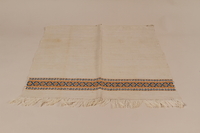
Fringed apron embroidered with a blue and orange geometric band recovered by Kato Ritter from her neighbors
Object
Colorful apron returned to 20-year-old Kato Ritter by her Catholic neighbors, the Oppel family, in Vilmany, Hungary, in July 1945. Kato’s family gave the apron to the Oppels to safeguard prior to their deportation during World War II (1939-1945). Kato wove the linen for the apron from flax plants grown on her family’s farm, and embroidered it in 1941. The family made their own noodles and, when doing so, always wore long aprons that covered them from their waist to their ankles. Nazi-controlled Germany occupied Hungary in March 1944, and one week later, 19-year-old Kato, her parents, David and Gizella, and her 17-year-old sister, Julianna, were deported from Vilmany to the Jewish ghetto in Košice, Czechoslovakia (now Košice, Slovakia). From there, they were transported to Auschwitz-Birkenau killing center, where everyone except Kato was gassed upon arrival. Kato was selected for forced labor, and sent to Peterswaldau concentration camp. The camp was liberated by the Soviet Army on May 8, 1945. That summer, Kato returned to Vilmany.
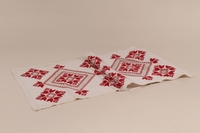
Table runner with a tatted and red embroidered design recovered by Kato Ritter from her neighbors
Object
Embroidered table runner returned to 20-year-old Kato Ritter by her Catholic neighbors, the Oppel family, in Vilmany, Hungary, in July 1945. Kato’s family gave the runner to the Oppels to safeguard prior to their deportation during World War II (1939-1945). Nazi-controlled Germany occupied Hungary in March 1944, and one week later, 19-year-old Kato, her parents, David and Gizella, and her 17-year-old sister, Julianna, were deported from Vilmany to the Jewish ghetto in Košice, Czechoslovakia (now Košice, Slovakia). From there, they were transported to Auschwitz-Birkenau killing center, where everyone except Kato was gassed upon arrival. Kato was selected for forced labor, and sent to Peterswaldau concentration camp. The camp was liberated by the Soviet Army on May 8, 1945. That summer, Kato returned to Vilmany.
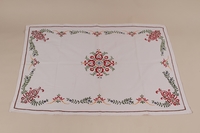
Tablecloth embroidered with a multicolored floral design recovered by Kato Ritter from her neighbors
Object
Embroidered tablecloth returned to 20-year-old Kato Ritter by her Catholic neighbors, the Oppel family, in Vilmany, Hungary, in July 1945. Kato’s family gave the tablecloth to the Oppels to safeguard prior to their deportation during World War II (1939-1945). Nazi-controlled Germany occupied Hungary in March 1944, and one week later, 19-year-old Kato, her parents, David and Gizella, and her 17-year-old sister, Julianna, were deported from Vilmany to the Jewish ghetto in Košice, Czechoslovakia (now Košice, Slovakia). From there, they were transported to Auschwitz-Birkenau killing center, where everyone except Kato was gassed upon arrival. Kato was selected for forced labor, and sent to Peterswaldau concentration camp. The camp was liberated by the Soviet Army on May 8, 1945. That summer, Kato returned to Vilmany.
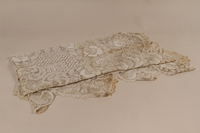
Crocheted lace tablecloth with a rose and scrollwork design recovered by Kato Ritter from her neighbors
Object
Lace tablecloth returned to 20-year-old Kato Ritter by her Catholic neighbors, the Oppel family, in Vilmany, Hungary, in July 1945. Kato’s family gave the tablecloth to the Oppels to safeguard prior to their deportation during World War II (1939-1945). Nazi-controlled Germany occupied Hungary in March 1944, and one week later, 19-year-old Kato, her parents, David and Gizella, and her 17-year-old sister, Julianna, were deported from Vilmany to the Jewish ghetto in Košice, Czechoslovakia (now Košice, Slovakia). From there, they were transported to Auschwitz-Birkenau killing center, where everyone except Kato was gassed upon arrival. Kato was selected for forced labor, and sent to Peterswaldau concentration camp. The camp was liberated by the Soviet Army on May 8, 1945. That summer, Kato returned to Vilmany.
Embroidery sampler depicting a woman and a cat recovered by Kato Ritter from her neighbors
Object
Embroidery sampler returned to 20-year-old Kato Ritter by her Catholic neighbors, the Oppel family, in Vilmany, Hungary, in July 1945. Kato’s family gave the sample to the Oppels to safeguard prior to their deportation during World War II (1939-1945). It was embroidered by Kato’s mother, Gizella Weissburg Ritter, in prewar Hungary. Nazi-controlled Germany occupied Hungary in March 1944, and one week later, 19-year-old Kato, her parents, David and Gizella, and her 17-year-old sister, Julianna, were deported from Vilmany to the Jewish ghetto in Košice, Czechoslovakia (now Košice, Slovakia). From there, they were transported to Auschwitz-Birkenau killing center, where everyone except Kato was gassed upon arrival. Kato was selected for forced labor, and sent to Peterswaldau concentration camp. The camp was liberated by the Soviet Army on May 8, 1945. That summer, Kato returned to Vilmany.



